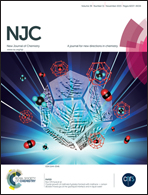Rhodamine-based field-induced single molecule magnets in Yb(iii) and Dy(iii) series†
Abstract
The reaction between the rhodamine-6G-2-(hydrozinomethyl) quinolin-8-ol (HQR1) ligand and Ln(tta)3·2H2O precursors (tta = 2-thenoyltrifluoroacetone) leads to the formation of a series of mononuclear complexes with formula [Ln(QR1)(tta)2]·(CH3OH)x(H2O)y (3–6) for (Ln = Yb, x = 1, y = 0 for 3; Ln = Dy, x = 1, y = 0.5 for 4; Ln = Tb, x = 2, y = 0 for 5; Ln = Ho, x = 2, y = 0 for 6) together with [Dy(QR1)2][NO3]·(CH3OH)(H2O) (2) and the reported [Yb(QR1)2][NO3]·(CH3OH)(H2O)0.5 (1), for the purpose of magnetic comparison. Their X-ray structures revealed that the coordination environment of each Ln(III) center is filled by two tta carboxylate groups and a tetrachelate N2O2 binding site coming from the deprotonated HQR1 ligand. The Yb and Dy complexes showed the field-induced slow relaxation of magnetization. Both Yb(III)-containing compounds were characterized by X-band EPR and magnetism studies, which revealed the different effective g values and slow paramagnetic relaxation. Comparison between two Yb(III) complexes 1 and 3 shows that the magnetoanisotropy and the barrier height of the magnetic relaxation are sensitive to the subtle change in the coordination environment of the central metal ion. However, in Dy3+ series, QTM is difficult to overcome even under the dc field and the subtle variation of the coordination environment leads to a tiny change in the energy barrier of slow magnetization relaxation. These results show that ligand-donating ability while maintaining molecular symmetry can be controlled to design single molecule magnets with enhanced relaxation barriers.


 Please wait while we load your content...
Please wait while we load your content...